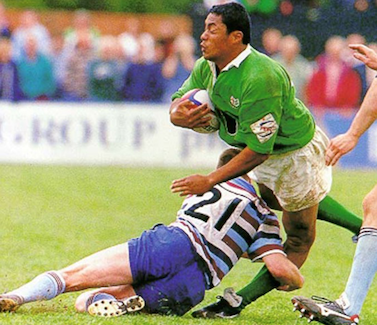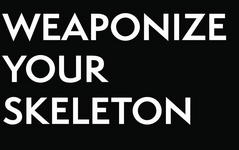A Difference You Can Taste

In the 28 years I’ve been teaching, the most common question I’ve heard is:
“How is what you do different from self-defense, self-protection, or fighting?”
(The question is usually about specific schools or popular styles, examples of which I refuse to list for reasons you’ll find at the end.)
The simplest answer is:
“Injury. We’re far more concerned with what’s happening inside of him, rather than what’s happening inside of you.”
In other words, something crushed, ruptured or torn — not the “cool move” that supposedly does that thing.
For a more involved explanation, here are the fundamental differentiators, including the visceral one:
– We strive to model the successful use of violence in our practice, based on observable reality — instead of trying to defend or protect ourselves or get into a fight. We don’t want to “win a fight”, we just want to deliver a beating. What the other person wants to do is immaterial. Violence is unidirectional and heavily favors the one doing it. The defender, not so much.
– Successful violence causes and exploits debilitating injury as a first principle and sole goal — the only thing that means anything in violence is ruptured anatomy. We seek to cause results similar to firearms (stripping the man of function until we achieve a nonfunctional state), using the relatively slow, heavy bullet of our mass leveraged by our skeleton. To this end we use similar training methodologies — working more like a tactical shooting course than a sparring match. (Slow is smooth, smooth is fast.)
– The human machine only breaks when subjected to catastrophic volume change, when tissues are compressed or stretched farther and faster than their elasticity will allow before failure. The action of the limbs alone (punching and kicking with no overrun) can produce useful injuries, but usually doesn’t. (This is why fights go on and on — people can easily withstand nonspecific trauma.) Body-weighted collisions with overrun get us the traumatic volume change we need to break things inside of people.
– In figuring out how to get results we start with the injury first, then work backwards from there, reverse-engineering the process to make a given sports accident happen on purpose. We are only interested in what’s happening inside of him, not what’s happening inside of you — result vs. technique, a broken knee instead of a knee-break move:

It’s his knee, but you can feel the difference in your gut.
– Beyond the “one-and-done” crash course (for raw effectiveness) we have a 10-year curriculum in writing that incorporates striking, joint breaking, throwing, knife, baton, and firearms into a seamless whole — meaning we’re never suddenly having to switch gears into “knife defense” or “gun disarms”. It’s all the same because it all hinges on causing injury and then exploiting that state change. The 10-year curriculum is about efficiency (getting an effective result more quickly, with less effort) but does not improve upon baseline effectiveness — if we both knock someone out they’re still KO’d, regardless of our relative efficiency. This is the curriculum we use to produce instructors.
In summary:
– Pure offense — not defense, protection or fighting
– Entirely directed toward causing debilitating injury
– Looking at the physics and physiology of collisions rather than techniques
– A 10-year curriculum, in writing
It’s important to note that I’m not saying what we do is “better” than anything else — effective violence is as old as hominids and no one has a patent on concussions. All training has the potential to work. The best training is the one you know in your bones you can make work for you. If someone looks at what we do and doesn’t think they could make it work, then they’re right. If a specific school, style or system makes more sense to them, then that would be the better choice. In the end all we have is some technical information that you may or may not find useful. That determination is up to the individual.
— Chris Ranck-Buhr


As a side note:
Which is more important, a knee-break technique or a broken knee?
A broken knee doesn’t require a knee-break technique—it is a symptom of circumstance, vulnerable anatomy subjected to a load of forces and inevitable leverage. Whether it happens by accident or on purpose is immaterial; the physical facts remain the same. If you’re going to make it happen on purpose, repeatedly and reliably, you need to study broken knees, and the circumstances surrounding that outcome, rather than knee-break techniques. Look at the desired result, not the hand-waving on the side where nothing happens.
What you do isn’t the important part—injury always starts with anatomy, followed by the volume of physics applied through that anatomy. This begins to narrow the focus of your personal movement as opinions of style are necessarily burned off so that form follows function. In other words, the movements required to break a knee will all begin to look the same. (There’s really only one way to use a shovel to dig a hole.) “Doing the move to the target” won’t necessarily do anything—making a knee bend 90˚ in the completely wrong direction will.
Hey Chris, I had a couple of questions for you.
1. What is the rough ETA of the 10 year curriculum?
2. What are the costs (estimates are fine)?
3. Is there a way to participate if I am on the east coast? (ie video/written information) I can make trips on occasion.
Thanks,
Kevin W.
Kevin—here are some answers:
1. What is the rough ETA of the 10 year curriculum?
I’m assuming you mean when it will be available to the general public online; as it’s really only useful to people training with an instructor, we’re restricting access to members-only at this time. The good news is that you have an excellent instructor on the East Coast (see #3 below).
2. What are the costs (estimates are fine)?
In San Diego, full membership is $120/mo (which includes access to all of our weekly classes, as well as monthly Six-Hour Saturdays and the members-only forum). While this is obviously the perfect thing for locals, it’s also convenient for those who can travel to San Diego once a month for the all-day session—we currently have clients who come from the San Francisco and Los Angeles areas, Las Vegas, and Phoenix—all of them on the instructor track. (We also offer any single Six-Hour Saturday for $297.) For East Coast classes, contact Sachin Makani for the cost of the monthly NYC sessions (below).
3. Is there a way to participate if I am on the east coast? (ie video/written information) I can make trips on occasion.
Sachin Makani runs a once-monthly group in the NYC area. Get in touch with him at makani@gmail.com for more information (cost, days/times, etc.).
Good luck with your training!